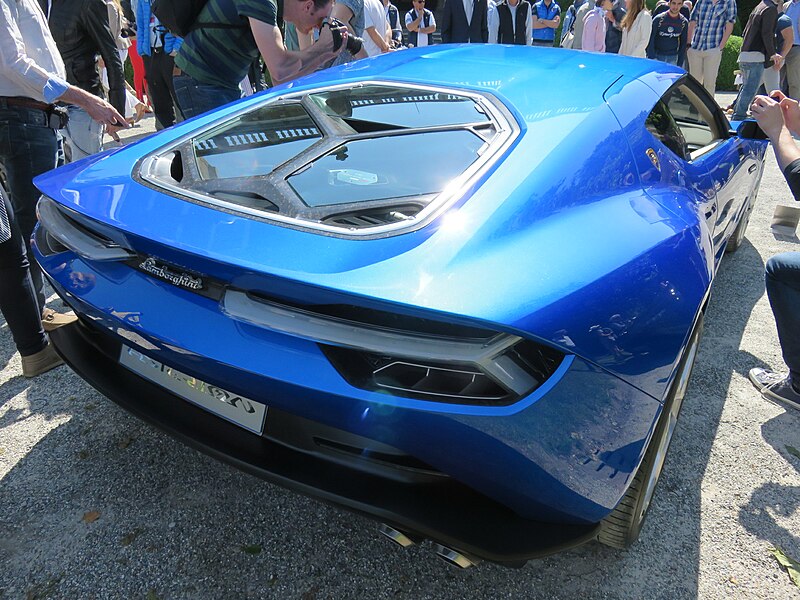400 GT Monza
The Lamborghini 400 GT Monza was a one-off two-seater sports car based on the 400 GT "Interim", featuring unique bodywork by Neri and Bonacini.
Giorgio Neri and Luciano Bonacini, who were already previously known for their work on the "Nembo" series of Ferraris, had been previously retained by Ferruccio Lamborghini to build the first prototype Lamborghini chassis and engine, the 350 GTV. They had acted as Lamborghini's chassis supplier, before turning that job over to Marchesi once production of the 350 GT was underway. Neri and Bonacini then turned their hand into their interpretation of a high speed Lamborghini GT sports car.
Originally meant to be called the "400 GT Neri and Bonacini" the name was simply shortened to "Monza". The car was reportedly built for an American client for the possibility of racing it in Le Mans. However, homologation problems put a quick end to that plan. The car was eventually sold off at the Barcelona Motor Show to a wealthy Spaniard, where it remained until the owner died in the early 1990s. In 1996, auction house Brooks (now Bonhams) was contacted by the family of the now deceased owner to appraise some other cars, when the 400 GT was discovered in storage. After nine years of negotiations, the car was finally put up for auction at Bonhams for a reported £160,000 to a UK collector.
Lamborghini 350GTV
The Lamborghini 350 GTV was a Lamborghini prototype and forerunner of its first production model, the 350 GT, presented to the public at the 1963 Turin Auto Show.
Built by Carrozzeria Sargiotto in Turin. Giorgio Neri and Luciano Bonacini built the tube frame chassis in Modena.[4] Giotto Bizzarrini developed a 3.5 litre dry sump racing-specification V12 engine, with an output of 255 kilowatts (347 PS; 342 bhp) at 8,000 rpm, and torque of 326 newton metres (240 lbf⋅ft), using the DIN measurement standard, for use in the car.
Ferruccio Lamborghini was dissatisfied with several design features of the 350 GTV, and with the state of tune of the engine. He commissioned Carrozzeria Touring to redesign the car to be more practical and had the engine detuned to 270 brake horsepower (201 kW; 274 PS) at 6,500 rpm for use in the production car. The new body and retuned engine resulted in the first production Lamborghini, the 350 GT.
Lamborghini Asterion
The Lamborghini Asterion LPI 910-4 (LPI is an abbreviation for Longitudinale Posteriore Ibrido) is a concept car manufactured by Lamborghini, which was unveiled in the 2014 Paris Motor Show. The car is named after a Minotaur called Asterion and was to be Lamborghini's first hybrid car. The half man – half bull Minotaur was chosen keeping in mind Lamborghini's tradition of naming their cars after a bull while alluding to its usage of different modes of power.
Lamborghini Athon
The Bertone company, a private company based in Italy, created the Lamborghini Athon to show their everlasting support for the Lamborghini company according to the Turin coachbuilder press release. The Lamborghini Athon was given its name because the car is a spider and made for fair-weather; the name makes reference to the Egyptian cult of the sun.
Lamborghini Bravo
The Lamborghini Bravo was a concept car designed by Marcello Gandini at Bertone for Lamborghini. It was first presented in 1974 at the Turin Auto Show.
The Bravo was designed to showcase ideas for a replacement to the Urraco. The completely working prototype featured a 3L 300 hp (220 kW) V8 that powered the rear wheels, and underwent nearly 168,000 miles (270,000 km) of testing before it was placed in the Bertone museum. It was never put into production, but many styling features were inspired by the Countach, including the angular features and the window arrangement, but the interior was never more than what was barely necessary to operate the vehicle.
In 1987 it was considered for production as a companion car to the Bertone built Fiat X1/9. That "Project 1" was, however, ended when Fiat stopped the production of the 1.5L SOHC engine and rear-mounted 5-speed trans-axle.
Car was sold in auction at Villa d'Este (Italy) on 21 May 2011, for the highest bidder of €588,000. Prior being offered at the auction the Bravo was the only car from the Bertone Museum that was "refreshed
Lamborghini Calà
Lamborghini Calà, also known as the Italdesign Calà, was a concept car designed for Lamborghini by Italdesign Giugiaro. It was first shown at the 1995 Geneva Motor Show. It was a completely functional prototype that never made it into production. Its name was derived from the Piedmentese dialect of Northern Italy and meant “look, over there!”
The Calà was designed to fill Lamborghini's need for a replacement for the Jalpa, which discontinued production in 1988 at the behest of then owners of the company, Chrysler. When Chrysler sold Lamborghini to Megatech in 1994, the Calà's design took shape, but when Megatech sold Lamborghini to the Volkswagen Group in 1998, the concept was shelved. The Jalpa replacement would not be found in Lamborghini's lineup until 2003, with the release of the Lamborghini Gallardo.
















.jfif)




No comments:
Post a Comment